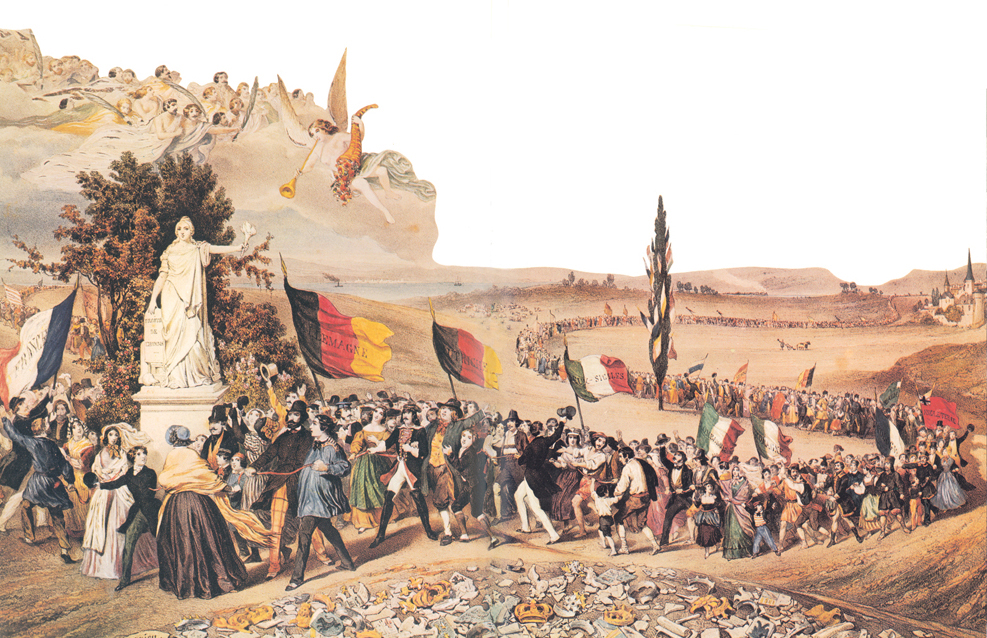Revolutions in France
Louis XVIII’s Constitutional Charter of 1814 was essentially a liberal constitution. It protected economic and social gains made by the middle class and the peasantry in the French Revolution, recognized intellectual and artistic freedom, and created a parliament with upper and lower houses. The charter was anything but democratic, however. Only a tiny minority of males had the right to vote for the legislative deputies who, with the king and his ministers, made the nation’s laws.
Louis’s conservative successor, Charles X (r. 1824–
Charles profited from early success in Algeria to repudiate the Constitutional Charter in 1830. After three days of uprisings in Paris, which sparked a series of revolts by frustrated liberals and democrats across Europe, Charles fled. His cousin Louis Philippe (r. 1830–
During the 1840s this sense of disappointment was worsened by bad harvests and the slow development of industrialization, which meant that living conditions for the majority of the working classes were deteriorating rather than improving. Similar conditions prevailed across continental Europe, which was soon rocked by insurrections: in northern Austria in 1846, in Switzerland in 1847, and in Naples in January 1848. In February full-
Louis Philippe, whose reign was labeled the “bourgeois monarchy” because it served the interests of wealthy elites, had refused to approve social legislation or consider electoral reform. Frustrated desires for change, high-

The revolutionaries quickly drafted a democratic, republican constitution for France’s Second Republic, granting the right to vote to every adult male. Revolutionary compassion and sympathy for freedom were expressed in the freeing of all slaves in French colonies, the abolition of the death penalty, and the establishment of national workshops for unemployed Parisian workers.
Yet there were profound differences within the revolutionary coalition in Paris. The socialism promoted by radical republicans frightened not only the liberal middle and upper classes but also the peasants, many of whom owned land. When the French masses voted for delegates to the new Constituent Assembly in late April 1848, they elected 500 monarchists and conservatives, only about 270 moderate republicans, and just 80 radicals or socialists. After the elections this clash of ideologies — of liberal capitalism and socialism — became a clash of arms. When the government dissolved the national workshops in Paris, workers rose in a spontaneous insurrection. Working people fought with courage, but the government had the army and the support of the French countryside. After three terrible “June Days” and the death or injury of more than ten thousand people, the republican army stood triumphant in a sea of working-
The revolution in France thus ended in failure. The February coalition of the middle and working classes had in four short months become locked in mortal combat. In place of a generous democratic republic, the Constituent Assembly completed a constitution featuring a strong executive. This allowed Louis Napoleon, nephew of Napoleon Bonaparte, to win a landslide victory in the December 1848 election based on promises to lead a strong government in favor of popular interests.
President Louis Napoleon at first shared power with a conservative National Assembly. But in 1851 Louis Napoleon dismissed the Assembly and seized power in a coup d’état. A year later he called on the French to make him hereditary emperor, and 97 percent voted to do so in a national plebiscite. Louis Napoleon then ruled France’s Second Empire as Napoleon III, initiating policies favoring economic growth and urban development to appease the populace. In 1870, on the eve of a disastrous war with Prussia (see “Bismarck and German Unification”), the emperor was still seeking with some success to reconcile a strong national state with universal male suffrage and an independent National Assembly.